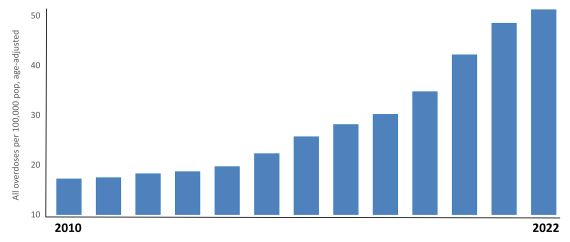Overdoses Continue to Rise Across Big Cities and Multiple Synthetic Drugs Are Involved in Nearly All Overdoses
July 16, 2024

Above: A bar graph depicts a rise in all overdoses per 100,000 pop. age-adjusted from 2010 - 2022.
In partnership with the Big Cities Health Coalition (BCHC), the Drexel Urban Health Collaborative created a new infographic using data from the Big Cities Health Inventory, an open-source platform providing health metrics for the 35 large U.S. cities that comprise the BCHC.
In 2022, averaged across BCHC cities, overdose rates were approximately 50% higher than the national average (per 100,000 population age-adjusted, the overdose death rate was 50.0 in BCHC cities compared to 32.6 for the U.S.). Nevertheless, the sharp increase over time in BCHC cities mirrors overdose trends seen across the U.S.
 Click to view infographic, "Drug Overdose Deaths in Big Cities: 2010-2022"
Click to view infographic, "Drug Overdose Deaths in Big Cities: 2010-2022"
In recent years, the overdose crisis in big cities has been fueled by the illegal manufacture of illicit synthetic drugs which are cheap and rapidly produced.
The synthetic opioid fentanyl is 50 times more potent than morphine. Starting in 2019, it has dominated the street opioid supply and been involved in the majority of overdoses in BCHC cities. Fentanyl is often combined with other synthetic drugs into a lethal drug cocktail.
Synthetic non-opioid tranquilizers are being used to enhance the sedative effect of opioids. Xylazine, a low-cost tranquilizer also known as tranq, is approved for veterinary use but is not approved for humans and there is low regulatory oversight of the drug. Currently, xylazine is the most common adulterant (contaminant) in the street opioid supply; in Philadelphia, more than 90% of fentanyl now includes xylazine.
Xylazine is increasingly involved with overdoses. Between 2019 and 2022, xylazine was involved in at least 2000 overdoses in BCHC cities.
The synthetic stimulant methamphetamine (also known as meth) was involved in at least one-quarter of total drug overdoses.
Given their role as entry points for emerging drugs, big cities serve as sentinel locations for the overdose crisis in North America. This highlights the importance of big cities continuing to:
Learn more about Big Cities Health Coalition's substance use policy initiatives.
To stay up-to-date on the Big Cities Health Inventory please make sure to follow both the Drexel Urban Health Collaborative (@DrexelUHC) and BCHC (@BigCitiesHealth) on Twitter or subscribe to our newsletter.
The Big Cities Health Inventory data platform is primarily funded by the U.S. Centers for Disease Control and Prevention through a cooperative agreement with the National Association of County and City Health Officials. The views expressed on the data platform do not necessarily represent the views of the funders.